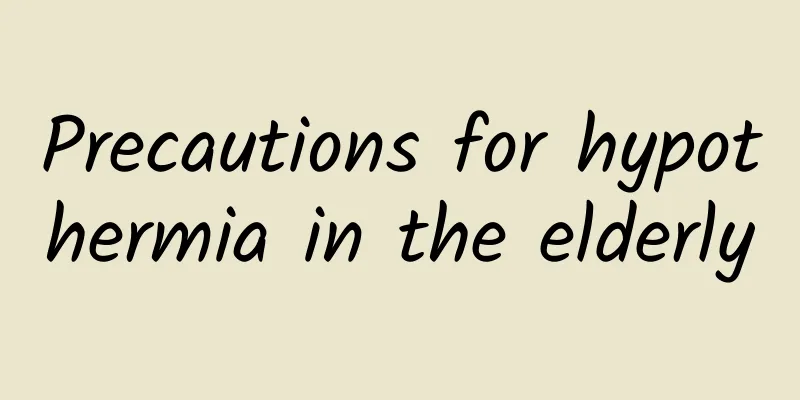Precautions for hypothermia in the elderly

|
We should all know that the normal body temperature of the human body is around 37℃. If the body temperature is above 37°C, it may be diagnosed as a low-grade fever or a high-grade fever. What if a person's body temperature is lower than 37℃? Doctors point out that if a person's body temperature is lower than 37℃, he or she may be suffering from hypothermia. So, what is hypothermia? Surveys have found that the elderly are a high-risk group for hypothermia. Therefore, if you have elderly people at home, you might as well take a look at the precautions for hypothermia in the elderly. The so-called low temperature is relatively high fever, which is a normal temperature of the human body for a long time. Here, the expert mainly wants to introduce to you: What is hypothermia? Why are the elderly more likely to suffer from hypothermia? What are the precautions for hypothermia in the elderly? Hypothermia is a condition in which the body's deep temperature (rectum, esophagus, tympanic cavity) is below 35°C (95°F). Hypothermia may be caused by heat production disorders, such as hypothyroidism. It can also be caused by excessive heat dissipation, such as prolonged exposure to low temperature environment. The body temperature of the elderly may not rise due to insufficient nutrition and calories, poor temperature regulation function, insufficient insulation, illness, etc. Precautions for hypothermia in the elderly Treat immediate damage and complications of hypothermia. ① Oxygen inhalation and assisted breathing: The patient's airway should be kept open, and oxygen should be continuously and adequately inhaled. If necessary, an artificial respirator should be used. ② Maintain fluid and electrolyte balance: expand body volume under the condition of controlling central venous pressure, and pay attention to correcting electrolyte disorders, especially hypokalemia. The electrocardiographic characteristics of hypokalemia in hypothermia are often unclear and may suddenly cause ventricular fibrillation, which should be corrected immediately. ③ Antibiotics: For comatose patients with hypothermia, there is often latent infection, so they should be treated with broad-spectrum antibiotics for 72 hours first, and then make appropriate adjustments after the blood culture results are reported. ④Corticosteroids and thyroxine: Many scholars no longer advocate the routine use of corticosteroids because the plasma cortisol levels in patients with hypothermia are elevated and their utilization is reduced. Thyroxine treatment is also limited to patients with hypothermia caused by myxedema, and the dosage should be small. Excessive dosage may cause myocardial infarction. Most metabolic abnormalities in hypothermia patients can be recovered with rewarming, and the effects of certain drugs such as atropine, bicarbonate, and insulin are also reduced when the body temperature is low, but these drugs may cause complications after rewarming. ⑤ Cardiopulmonary resuscitation: If ventricular arrhythmia cannot respond quickly to rewarming, lidocaine should be used for treatment. Digitalis preparations are only used when heart failure occurs. When the patient is hypothermic, the effects of electric shock and pacing are poor. If dangerous arrhythmias occur during rewarming, appropriate treatment should be given. All intravenous fluids were warmed to normal or slightly above normal body temperature. Death is often caused by cardiac arrest or cardiac arrhythmia. The body temperature is different each time a cardiac event occurs, but if the body temperature is <29.4℃, the risk of death is very high, especially for patients with existing heart disease. Moving or overstimulating a hypothermic patient can induce arrhythmia, so special caution should be taken during operation. If the patient's body temperature is significantly too low, resuscitation during rewarming should be active and persistent until the body temperature rises to at least 35.8℃. Do not rashly declare the patient dead before cardiopulmonary resuscitation completely fails. In addition, various underlying diseases that cause hypothermia should be actively treated. Many patients with hypothermia can return to normal body temperature within 12 to 24 hours after proper rewarming, but the prognosis depends on the severity and duration of hypothermia and the nature of the underlying disease. The lower the deep temperature, the higher the mortality rate; the longer the freezing and hypothermia last, the more serious the metabolic disorders will be, and the more likely complications will occur; underlying diseases also affect the prognosis, especially for the elderly who often have various co-existing diseases. If the disease that induces hypothermia is recoverable or treatable, the prognosis is good, otherwise the prognosis is poor. From this, it can be seen that families with elderly people at home need to pay special attention to observing changes in the elderly's body temperature. If it is found that the elderly's body temperature is below 35℃ for a long time, it is recommended to take them to the hospital for examination and treatment. In addition, while treating hypothermia, the elderly should also understand some precautions about hypothermia in the elderly, so as to help them recover as soon as possible. |
<<: Alzheimer's disease treatment
>>: Symptoms of emphysema in the elderly
Recommend
What to eat to nourish the uterus after miscarriage
Nowadays people's minds are very open and pre...
Feeling hot with cold
Feeling hot when you have a cold is very common i...
The dosage of the traditional Chinese medicine Evodia rutaecarpa is based on the condition of the disease.
The traditional Chinese medicine Evodia rutaecarp...
Is Xiao Chaihu Decoction effective in treating colds?
Xiao Chaihu Decoction is relatively effective in ...
What are the massage techniques in traditional Chinese medicine?
There are many massage methods in traditional Chi...
What medicine should I take for less menstrual flow and dark color?
Menstruation is a very important physiological fu...
Can I eat bird's nest when I have a cold?
Cold is a very common disease. This kind of disea...
What is the cause of the red spot on the upper jaw?
If there are red spots on the palate, it is gener...
How to regulate heavy cardiac afterload?
The load on the heart is divided into preload and...
Tips for Deepening Double Eyelids
If the double eyelids are shallow, sometimes you ...
What can't you eat if you have diarrhea?
In spring, when everything starts to grow, it is ...
Is it bad for your health if your jade turns yellow?
Jade is an accessory that many people like. Peopl...
What fruits can nourish the lungs? Eat these four kinds
In autumn, moistening the lungs is the focus of p...
White liquid flowing from below
For women, symptoms of itching and discharge of w...
What are the causes of bruises on the chin after hyaluronic acid injection?
If women want to change the image of their chin, ...









